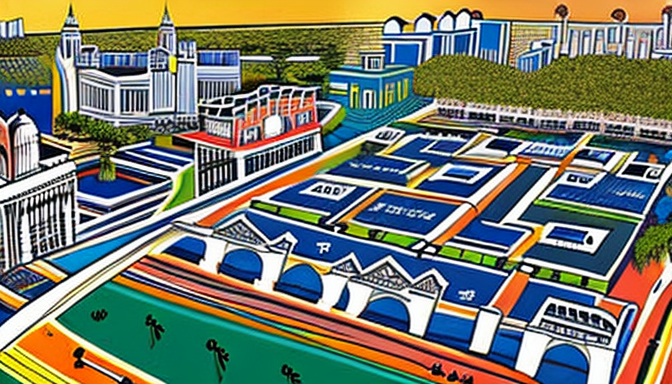This article delves into the rich historical tapestry of Karachi, showcasing its evolution through maps and visuals that highlight significant events, cultural shifts, and urban development over the years.
Imagine standing on the bustling streets of Karachi. The air is thick with stories. Each corner, each building has a tale to tell. Through vintage photographs and historical maps, we can embark on a visual journey that captures the essence of this vibrant city. From its humble beginnings as a small fishing village to becoming a thriving metropolis, Karachi’s history is a fascinating narrative.
As we explore these visuals, we can see how the city transformed over the decades. Take a look at a map from the early 1900s. It shows a different Karachi—one with sprawling coastlines and fewer buildings. Fast forward to today, and you’ll find a bustling urban landscape filled with towering skyscrapers and busy markets.
These images do more than just depict a city; they reveal the heart of Karachi. They show us:
- **Cultural shifts** that shaped the community.
- **Significant events** that left lasting impacts.
- **Urban development** that reflects economic growth.
So, why does this matter? Understanding Karachi’s past helps us appreciate its present. Each visual piece is a puzzle, fitting together to form the larger picture of a city that continues to evolve. Join us on this exploration, and let’s uncover the layers of history that make Karachi truly unique.
Historical Landmarks of Karachi
Karachi is a city that wears its history like a badge of honor. When you stroll through its bustling streets, you can’t help but feel the echoes of the past. Each landmark tells a story, a tale of resilience and change. From the majestic Frere Hall to the iconic Quaid-e-Azam’s Mausoleum, these structures are more than just buildings; they are windows into the soul of the city.
Take a moment to consider the Frere Hall. Built in 1865, it stands as a testament to British colonial architecture. Imagine the gatherings that took place here, where ideas were exchanged, and futures were shaped. Or think about the Mohatta Palace, a stunning example of Indo-Saracenic architecture, which has witnessed countless stories unfold within its walls. Each corner of Karachi has its own unique narrative.
As we dive deeper into Karachi’s past, vintage photographs and historical maps reveal how the city has transformed. For instance, the area around Empress Market once buzzed with the sounds of vendors and shoppers, a vibrant hub that remains lively today. The evolution of these landmarks showcases not just architectural changes but also the shifting dynamics of its people.
In essence, these historical landmarks are like time capsules. They remind us of who we were and guide us toward who we are becoming. So, next time you find yourself in Karachi, take a moment to appreciate these magnificent structures. They are not just bricks and mortar; they are the heartbeat of a city rich in history.

Urban Development and Growth
Karachi is a city that never sleeps. Its urban landscape tells a story of constant change and development. Imagine walking through the bustling streets, where every corner has a tale to tell. From its humble beginnings as a small fishing village to becoming one of the largest cities in the world, Karachi’s growth is nothing short of fascinating.
As you explore its vintage photographs and historical maps, you can almost feel the pulse of the city. Each image captures a moment in time, revealing how the skyline has transformed. For instance, take a look at the iconic Frere Hall, which stands as a symbol of the city’s colonial past. It’s not just a building; it’s a reminder of the rich history that shaped Karachi.
But it’s not just about the old landmarks. The city has seen rapid growth in infrastructure. New neighborhoods have sprung up, driven by an ever-increasing population. This growth has brought challenges too, like traffic congestion and housing shortages. Yet, the spirit of Karachi remains resilient.
Here’s a quick overview of the city’s transformation:
| Year | Milestone |
|---|---|
| 1843 | British annexation of Karachi |
| 1950s | Rapid population growth begins |
| 2000s | Expansion of infrastructure projects |
In conclusion, Karachi’s urban development is a captivating journey. It’s a city that embraces its past while looking forward to the future. The blend of history and modernity makes Karachi a unique place to explore.
Frequently Asked Questions
- What is the significance of Karachi’s historical landmarks?
Karachi’s historical landmarks, like the Quaid-e-Azam’s Mausoleum and the Mohatta Palace, are more than just structures; they are the stories of our past. Each landmark reflects the cultural shifts and pivotal moments that have shaped the city, making them vital to understanding Karachi’s identity.
- How has urban development impacted Karachi?
The urban development of Karachi is like a living organism, constantly evolving. As the population swells and economic conditions change, the city’s infrastructure adapts, leading to new neighborhoods and commercial hubs. This growth has both positive and negative effects, including increased opportunities but also challenges like congestion and resource management.
- Are there resources to explore Karachi’s history visually?
Absolutely! There are numerous online archives, museums, and local exhibitions that feature maps and visuals documenting Karachi’s history. These resources offer a fascinating glimpse into how the city has transformed over the years, making history accessible and engaging for everyone.